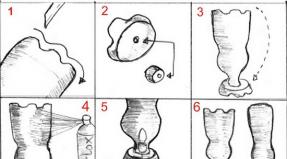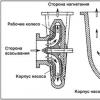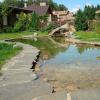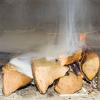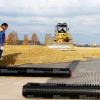Fire retardant treatment of a log house: the choice of a fire retardant composition
The irresistible desire of the inhabitants of megacities to at least one step closer to nature led to the rapid development of suburban construction. It's not hard to understand. That the most popular form of suburban real estate is a wooden house, living in which is characterized by a number of advantages that life in a brick building cannot give. Log houses and bathhouses built from environmentally friendly wood, in their originality, environmental friendliness, internal microclimate and comfort, are significantly superior to buildings made from other building materials. Due to the fact that increased attention is paid to suburban construction, there is probably no such homeowner who does not know that a quality log house will be required to build a reliable home. To carry out its preparation, before starting construction, it is necessary to prepare the material - wooden logs. Wood, which is based on cellulose, is in itself a favorable environment for the development of mold and microorganisms, and, given the fact that the log house is constantly in the open air, as well as in conditions of constantly changing temperature and humidity, favorable conditions are created that accelerate the damage to wood fungus and other microorganisms. To prevent premature loss of the original appearance of the building and damage to the wood by mold, it is necessary to treat the log house with an antiseptic, which is an integral stage in the construction of any structure from a log house. How to properly process a log house and how to choose an antiseptic - read on.
Antiseptic treatment of log cabins: the urgency of the problem
Being in conditions of constant exposure to ultraviolet radiation, the wood loses its original appearance, gradually crumbling and acquiring gray shades. Despite the fact that this does not affect the strength of the wood in any way, however, it does not deliver pleasant emotions either, since the appearance of the building is irrevocably deteriorating. To prevent such harmful effects, it is enough to apply the appropriate paint and varnish or antiseptic. One of the varieties of bacterial damage to a log building is mold damage, which poses no less danger to wood. In the old days, the defeat of a white construction fungus (mold) was considered a construction "plague", to prevent the further spread of which houses had to be burned. Today, mold is no longer as scary as it used to be, and in order to prevent its occurrence, it is also timely enough to carry out an antiseptic treatment of the log house.

In addition to white fungus, there are a large number of bacterial agents that cause wood decay. These include: red, gray, green and other types of rot. But the greatest danger among them is blue rot or the so-called "blue", favorable conditions for the development of which are fresh cut, high humidity, poor ventilation in the premises and low ambient temperature. The presence of "blue", which, spreading, can affect up to 70-80% of the wood in one week, indicates a fungal infection and indicates the imminent decay of the wood. Unlike the white fungus (mold), the development of which can be stopped, it makes no sense to fight the "blue" fungus, and its appearance must be prevented at the stage of material procurement. And the use of an antiseptic will help in this.
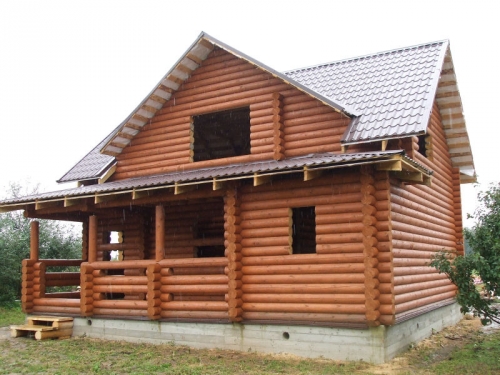
Log cabins photo
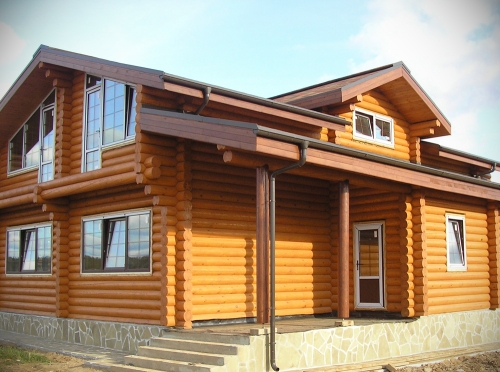
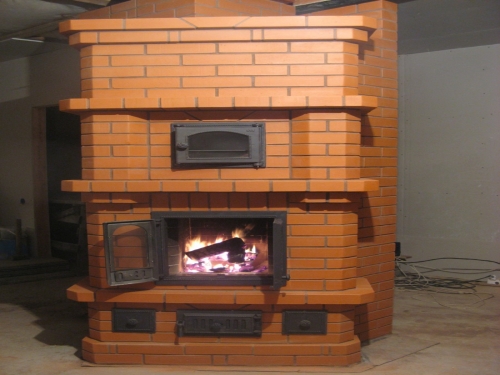
What does the protective treatment of the log house include?
In addition to the antiseptic treatment of the log house, there is a need for its complex treatment, which implies a number of measures, the implementation of which will ensure the comprehensive protection of wood. Distinguish between internal and external processing of wood.
Outdoor wood processing
Due to the fact that the outer side is constantly in the open air, it is exposed to adverse environmental factors such as precipitation, sudden temperature changes and direct ultraviolet radiation. All this has a negative impact on the quality of the material and contributes to the active reproduction of mold and fungi in wood, the appearance of biological pests and the acceleration of decay. To prevent this, it is necessary to carry out antiseptic treatment of wood, which will provide biological, bacteriological and chemical protection of wood. Since wood is characterized by high flammability, it also needs fire retardant treatment.
Another problem that needs to be addressed is the appearance of cracks on the surface of the wood, which occur when the wood dries out after it is moistened, especially when exposed to elevated temperatures or when water freezes in microcracks. To prevent this problem, it is necessary to carry out additional processing of the log house, which, in addition to solving this problem, will give the building the desired decorative appearance. Grinding the log house will help to cope with the solution of this problem.
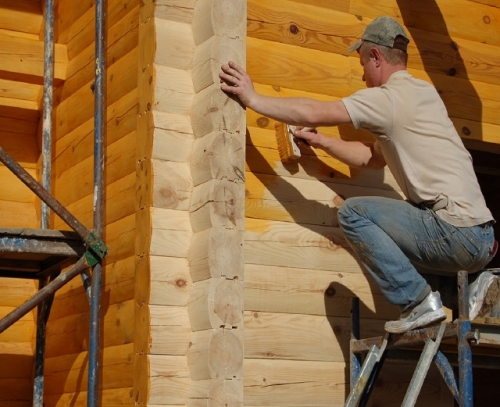
Internal wood processing
Due to the fact that the inner side of the log house is in relatively favorable conditions, it does not need special treatment. However, this situation is radically changing when it comes to a wooden bath, the inner walls of which are in conditions of high humidity and high temperatures. With this in mind, they, like the outside of the log house, need antiseptic and fire retardant treatment.
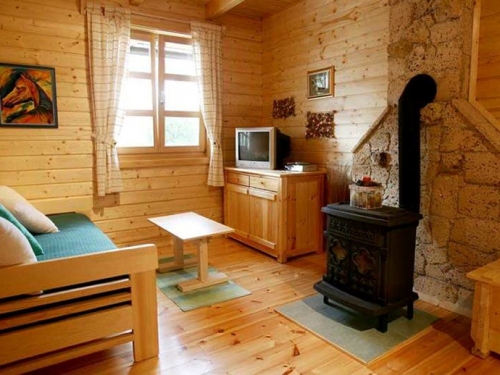
Wooden frame photo
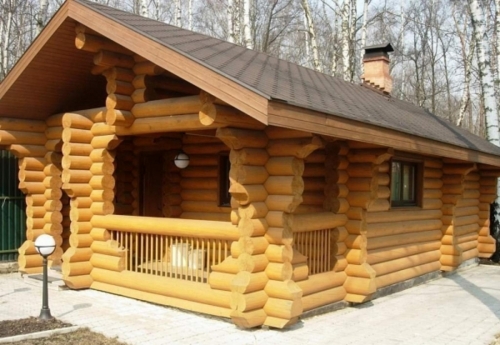
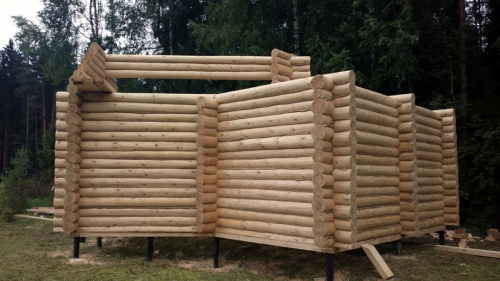
Grinding a log house: how to machine a log house?
Grinding a log house, which is an integral step in outdoor processing, is a laborious process that requires specialized skills and tools. Grinding a log house or its mechanical processing is the first stage of complex processing of a log house, which allows you to eliminate bumps, microcracks and bark residues. In addition, a log house that has been previously sanded absorbs fire retardant and antiseptic compounds more efficiently, which significantly reduces their consumption. Sanding the log house allows you to improve the appearance of the log house and effectively emphasize the natural texture of wood.
To ensure the effectiveness of grinding, it is carried out after the surface layer of wood has dried, when the texture and color of the wood have not yet changed. Grinding raw wood is not advisable, as it contributes to the scuffing of wood fibers and damage to the wood structure.
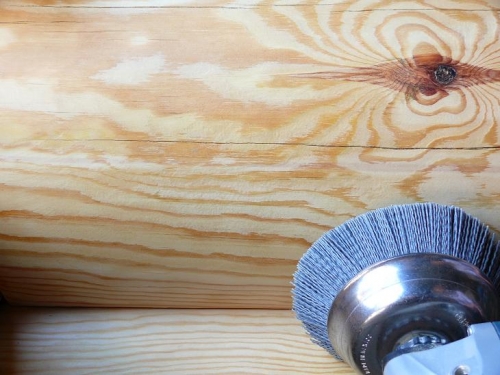
The easiest way to grind wood is to process it with a grinder equipped with an abrasive disc. If you want to improve the quality of processing, as well as speed up the process, you can use a grinder equipped with nozzles that are characterized by varying degrees of grit. For the final cleaning of the log house, use a fine-grained nozzle. When finished, use a vacuum cleaner to remove sawdust.
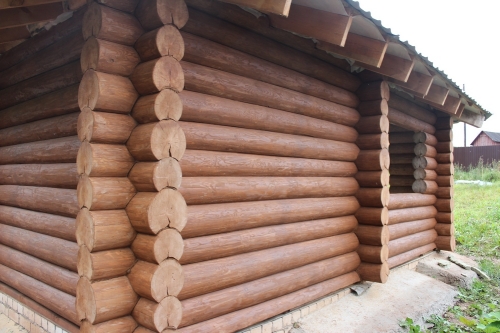
Fire retardant treatment of a log house: the choice of a fire retardant composition
An equally important stage in the preparation of the log house is fire retardant treatment, which involves the impregnation of wood with specialized compounds. The action of flame retardants is based on their ability, when exposed to open fire or high temperatures, to release substances that form a foamy fire-retardant layer that prevents access to oxygen and thereby stops ignition and the spread of fire.
The most common fire retardants that have won the trust of consumers are the Pirilax compositions. For the treatment of the inner surface of the log cabins of saunas and baths, it is recommended to use the composition of the SS-20 brand, which can withstand prolonged exposure to high temperatures (up to 110 degrees). To process the outside of the log house, it is recommended to use the compositions of the "Lux" and "3000" brands, which can be applied both with a brush and with a spray. The component composition of flame retardants contributes to their deep penetration into the wood structure, which significantly reduces material consumption. The absence of substances toxic to humans in the impregnation guarantees their environmental safety.
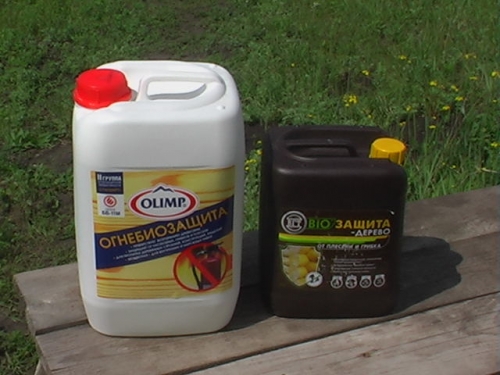
The compositions of the above brands are far from the only means used for the fire-retardant treatment of wood. Flame retardants, made in accordance with innovative technologies, also have antiseptic properties.
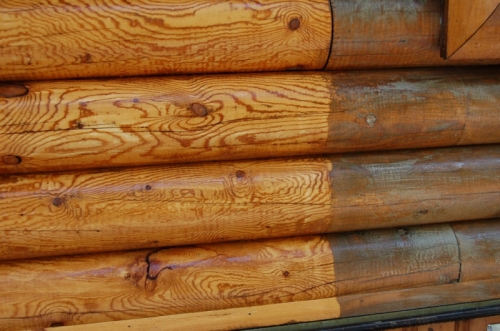
Antiseptic processing of a log house: a guide for a novice master
In order to increase the operational life of the log house and preserve its original appearance, it is necessary to carry out one more stage of integrated wood protection - antiseptic treatment, which is carried out both from the outside and from the inside. The use of an antiseptic agent not only helps to prolong the durability of timber and logs, but also reliably protects the log house from the effects of wood-eating insects, which can render any structure made of wood unusable.
In order to conduct a high-quality antiseptic treatment, it is necessary to take a responsible approach to the choice of an antiseptic, which is a tool that has a bactericidal and fungicidal effect, which guarantees the protection of the log house from mold and microorganisms. Since antiseptic treatment is carried out from the outside and from the inside, it is important to understand the types of antiseptics, the effectiveness of which depends on their type and proper application.
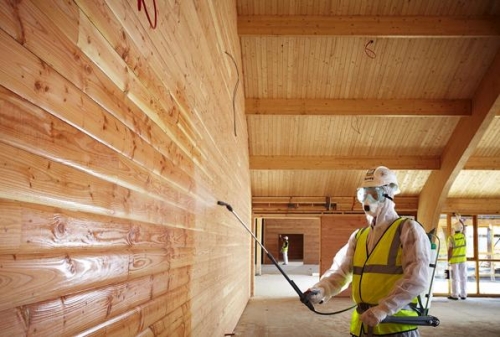
How to choose the right antiseptic for a log house?
Experts propose to distinguish between two types of antiseptics:
- Washable antiseptics , intended for internal processing of a log house and characterized by low resistance to precipitation;
- Hard-to-wash antiseptics , which include synthetic and natural oils, are designed to treat the outside of the log house and are characterized by resistance to leaching under the influence of precipitation. Their only drawback is slow drying.
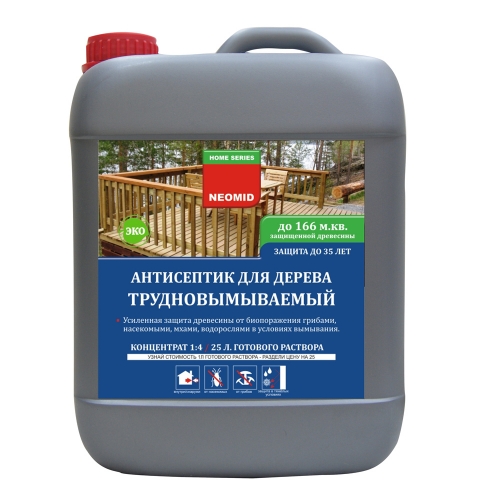
Today, the construction market offers a wide range of antiseptics from both domestic and foreign manufacturers. Due to the variety of tools presented, craftsmen who do not have sufficient experience may encounter a number of difficulties. To simplify the choice of antiseptic composition, experts have proposed several rules, following which you will not go wrong when choosing an antiseptic.
Rules for choosing an antiseptic composition:
Rule #1. Give preference to the means of trusted manufacturers who have managed to establish themselves in the construction market. Giving preference to a well-known brand, you can be sure of the quality of the selected composition;
Important! The most popular products that are in demand among consumers are the products of domestic brands "Neomid 200" and "Senezh". As for foreign manufacturers, Tikkurila and Teknos brands are in the greatest demand.
Rule #2. The following rule is relevant not only for antiseptics, but also for any other product. High-quality antiseptics cannot be cheap, and therefore, experts recommend giving preference to products that are at least in the middle price category. In addition, it is not recommended to purchase funds from the hands, since by buying antiseptic compounds in a reliable online store, you are less likely to run into a fake, which can be not only ineffective, but also toxic;
Rule number 3. The label of a quality antiseptic composition should indicate that it is designed to protect against all types of biological agents: insects, fungus, rot and mold. In addition, in the process of implementing the tool, the supplier must comply with the conditions for its storage;
Rule #4. For external processing, it is necessary to use antiseptics that are difficult to wash out, which, despite a longer period of preservation of their properties, need to be periodically updated. This is due to the fact that any product, under the influence of moisture, will be washed out, and the outer coating needs to be updated.

How to carry out antiseptic treatment of wood? Walkthrough
The treatment of the log house with antiseptic compounds is carried out several times, at various stages of construction. Currently, the manufacturer often offers wood that has already undergone preliminary antiseptic treatment.
Important! Even though the cost of antiseptic treated wood is somewhat higher than that of an untreated log house, you will save time and money during the construction process, since you will not have to treat the log house immediately after assembly. Factory pre-treatment is characterized by deep penetration of antiseptic compounds, which guarantees reliable protection of wood.
Many craftsmen ask themselves the question: “Is it necessary to process a fresh log house immediately after its purchase?”, And there are also often disputes regarding the processing of a log house immediately after its assembly.
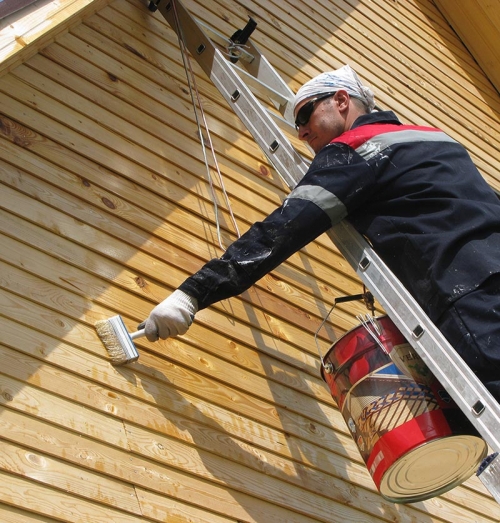
Despite the fact that some builders believe that the application of antiseptic impregnations reduces the efficiency of air exchange, preventing the log house from drying out in time, however, this assumption is fundamentally wrong. Modern water-based products do not reduce the environmental friendliness and quality of the log house. Having carried out the primary antiseptic treatment of the log house, you will reliably protect the log house for six months until it reaches its final drying and shrinkage, after which you can carry out the final processing of the log house.
Important! As for the time frame for processing the log house, according to experts, the final processing of the log house is best done after the wood has dried (19-20% moisture content), after which the final finishing can be carried out.
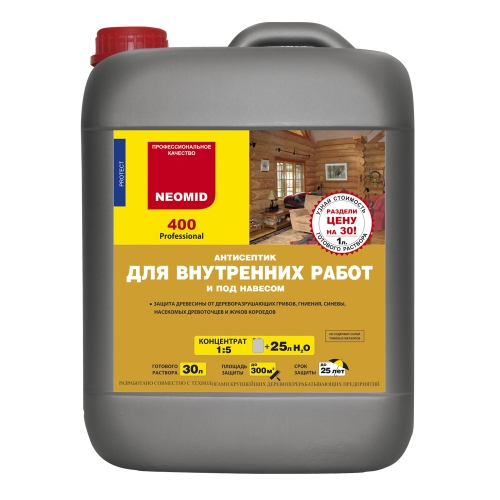
There are several options for processing wooden log cabins:
Manual processing, implying the application of antiseptic compounds with a roller or brush. Despite the fact that this work is long and painstaking, applying antiseptics by hand allows you to provide reliable protection for every centimeter of wood. If you have enough time, give preference to this particular method, as it allows you to qualitatively process the joints of timber or logs, the end parts of the log house and other problem areas;
Applying compositions with sprayers- a more modern way of antiseptic treatment, which can significantly save time. Modern spray guns allow you to distribute antiseptic compounds over the entire outer surface of the log house in a short time.
Important! In the process of applying the antiseptic, make sure that there is not a single untreated area left. To make it easier to control the application of the antiseptic composition, you can purchase tinted products. The use of a tinted composition is advisable if you plan to carry out decorative finishing in the future.
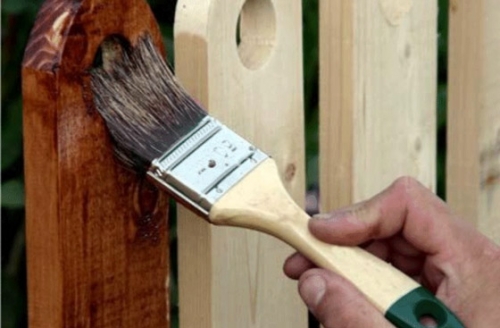
In both cases, antiseptic impregnation is applied in two layers. The first layer is applied after the final drying of the wood (treatment in rainy weather is strictly prohibited) and left for several days to dry. After that, re-processing is carried out. If you use a brush, the antiseptic composition must be applied evenly in even strokes, periodically changing the direction of the brush.
Recently, antiseptics based on oils or wax have been effectively used, giving the surface some decorative effect. Experts recommend using antiseptics based on tree resins, beeswax and natural oil (usually linseed).
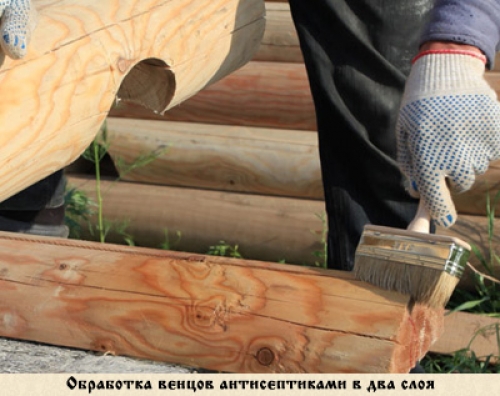
Often there are disputes about the need to treat log cabins with antiseptic compounds. One side claims that it is necessary to treat natural material with chemical compounds, citing the fact that quite recently the log cabins were left unprocessed, and the other quite justifiably claims that the tools used in modern construction guarantee maximum air exchange and extend the operational life of wooden buildings.
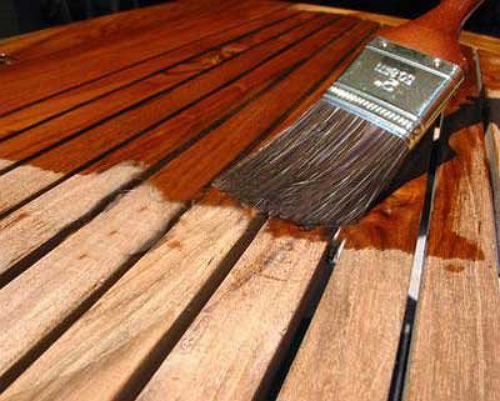
Protective antiseptic impregnations significantly prolong the effective operation of log houses, which covers any theoretically expected harm. The practical use of antiseptics confirms that the use of antiseptic compounds contributes to the maximum preservation of the external beauty and natural color of wood, and also protects against aggressive natural factors. From a material point of view, the effectiveness of the use of impregnations is also justified, since it is better to spend a small amount on an antiseptic than to subsequently dismantle the log house and replace elements that have rotted and been attacked by insects.


